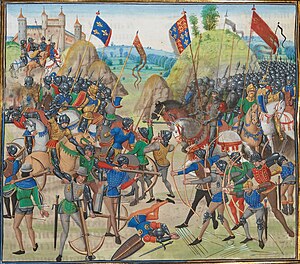Ranged weapon
This article needs additional citations for verification. (January 2017) |

A ranged weapon[dubious – discuss] is any weapon that can engage targets beyond hand-to-hand distance, i.e. at distances greater than the physical reach of the user holding the weapon itself. The act of using such a weapon is also known as shooting. It is sometimes also called projectile weapon or missile weapon because it typically works by launching solid projectiles ("missiles"), though technically a fluid-projector (which throws out pressurized streams of liquid or even gas) and a directed-energy weapon (which does not involve any tangible projectile) are also ranged weapons. In contrast, a weapon intended to be used in hand-to-hand combat is called a melee weapon.
Ranged weapons give the attacker an advantage (especially when performing an ambush) because the target is often getting hit from beyond immediate visual range, therefore making it more difficult for the defenders to react and hit back effectively.[1] It also puts distance between the attacker and the opponent, which is a safer combat option since the close physical contact during melee fights often puts the attacker within the immediate striking range of enemy counterattacks and thus at an equal risk of getting hurt or killed.
The line between ranged and melee weapons is not entirely definite; for instance, spears, axes, daggers, and knives can be used for both throwing and hand-to-hand combat, depending on purpose and situation, and a ranged weapon can also be used as a melee weapon in close encounters, such as the buttstock of a rifle used for butt-stroking, a rifle with a bayonet fixed to the front end used as an improvised spear, a handgun used for pistol-whipping, and even an arrow being used as a hand pick in desperate situations.
Early ranged weapons often included specifically designed hand-thrown weapons such as darts, javelins, slings, as well as elastic weapons such as slingshots, bows and crossbows; and more complex siege engines like stone throwers, catapults, ballistas and trebuchets. These ranged weapons were extremely effective in ancient and early medieval warfare, especially when used en masse, as they gave the wielder an opportunity to launch multiple rounds of attack before an enemy armed with melee weapons or shorter-ranged missile weapons could even get close enough to pose a threat. After the invention of gunpowder and the development of firearms, gun-type pneumatic ranged weapons became the dominant weapon of choice in armed conflicts, even in close combat. In modern warfare, ranged weaponry is also used both tactically and strategically in the form of long-range artilleries, rockets, guided missiles, and unmanned aerial vehicles (aka drones). The maximum effective range of a weapon is the greatest distance from which the weapon can be fired while still consistently inflicting casualties or damage. When a modern missile can be launched from beyond the effective range of counterattack, it is termed a standoff missile.
List of ranged weapons
[edit]Prehistoric, ancient, and medieval period
[edit]

Early modern period
[edit]- Pneumatic-propelled
- Airgun (e.g. Girandoni air rifle)
- Explosive-propelled
Late modern and contemporary period
[edit]

Most modern projectile weapons fall into the broader category of either direct fire or indirect fire, with the former often being regarded as guns and the latter as artillery. While some are small and light enough to be operated by individuals (i.e. small arms and grenade launchers), most require a team of individuals to service, maneuver and operate.
- Small arms and light weapons
- Crew-served weapon
- Heavy weapon and vehicle-mounted weapon systems
- Artillery
- Rocket weaponry
- Torpedo
- Flamethrower
- Water cannon / waterjet disruptor
- Aerial weapon
- Loitering munition (expendable warhead as UCAV)
Future and conceptual weapon period
[edit]- High-acceleration linear motor
See also
[edit]- Trajectory of a projectile
- Siege engine
- List of artillery
- List of missiles
- List of missiles by nation
References
[edit]- ^ McDonald, James. "Medieval Weapons". Medieval Weapons & Armour. Retrieved 22 May 2015.
Further reading
[edit]- Gray, David (2002) Bows of the World. The Lyons Press. ISBN 1-58574-478-6
- (1992) The Traditional Bowyers Bible Volume 1. The Lyons Press. ISBN 1-58574-085-3.
- (1992) The Traditional Bowyers Bible Volume 2. The Lyons Press. ISBN 1-58574-086-1.
- (1994) The Traditional Bowyers Bible Volume 3. The Lyons Press. ISBN 1-58574-087-X.
- The ballistics of the sling, Thom Richardson, Royal Armouries Yearbook, Volume 3 1998.
External links
[edit]- Short Bows and Long Bows: Scaling effects in archery
- Sling Weapons—Their evolution
- The Sling – Ancient Weapon
- "Secrets of Lost Empires: Medieval Siege" (building of and history of trebuchets), from the NOVA website
- Modern and Civil War Era Cannon Information (Wayback Machine copy)
